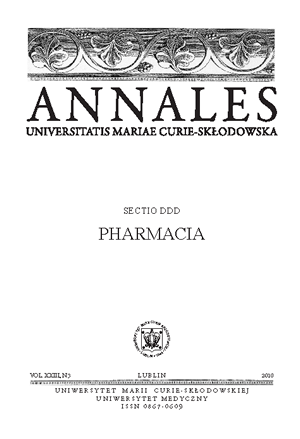Blokada enzymu-1 zależnego od inozytolu sensora stresu retikulum endoplazmatycznego zmienia ekspresję cyklin genów hamujących wzrost (GAS) w komórkach glejaka
Słowa kluczowe:
enzym-1 zależny od inozytolu, ekspresja genu, cykliny A2, D3, E2 i G2, kinaza cyklino-zależna CDK4, geny hamujące wzrost GAS1 i GAS6, komórki glejakaAbstrakt
Zbadano wpływ niedoboru enzymu-1 zależnego od inozytolu (IRE-1) na ekspresję cyklin i genów kinazy zależnej od cyklin (CDK) jak też genów hamujących wzrost (GAS) w komórkach glejaka i modyfikowanych komórkach glejaka bez aktywności kinazy IRE-1 i rybonukleazy. Ekspresja cyklin A2, D3, E2 i G2 mRNA była istotnie wyższa w komórkach z niedoborem IRE-1 w porównaniu z kontrolną linią komórek. Zahamowanie aktywności IRE-1 w sposób istotny indukowało ekspresję genów hamujących wzrost GAS1 i GAS 6. Wyniki badań wskazują, iż ekspresja genów GAS oraz cyklin w komórkach glejaka zależy w głównej mierze od aktywności kinazy IRE-1 i rybonukleazy.
Bibliografia
1. Acosta-Alvear D. et al.: XBP1 controls diverse cell type- and condition-specific transcriptional regulatory networks. Mol. Cell, 27, 53, 2007.
2. Aragón T. et al.: Messenger RNA targeting to endoplasmic reticulum stress signalling sites. Nature, 457, 736, 2009.
3. Bi M. et al.: ER stress-regulated translation increases tolerance to extreme hypoxia and promotes tumor growth. EMBO J., 24, 3470, 2005.
4. Blais J.D. et al.: Transcription factor 4 is translationally regulated by hypoxic stress. Mol. Cell. Biol., 24, 7469, 2004.
5. Denko N.C.: Hypoxia, HIF1 and glucose metabolism in the solid tumour. Nature Rev. Cancer, 8, 705, 2008.
6. Drogat B. et al.: IRE1 signaling is essential for ischemia-induced vascular endothelial growth factor-A expression and contributes to angiogenesis and tumor growth in vivo. Cancer Res., 67, 6700, 2007.
7. Fels D.R., Koumenis C.: The PERK/eIF2a/ATF4 module of the UPR in hypoxia resistance and tumor growth. Cancer Biol. Ther., 5, 723, 2006.
8. Guan D. et al.: N-acetyl cysteine and penicillamine induce apoptosis via the ER stress response-signaling pathway. Mol. Carcinogen, 49, 68, 2010.
9. Han D. et al.: A kinase inhibitor activates the IRE1alpha RNase to confer cytoprotection against ER stress. Biochem. Biophys. Res. Commun., 365, 777, 2008.
10. Hollien J. et al.: Regulated Ire1-dependent decay of messenger RNAs in mammalian cells, J. Cell. Biol., 186, 323, 2009.
11. Korennykh A.V. et al.: The unfolded protein response signals through high-order assembly of Ire1. Nature, 457, 687, 2009.
12. Lin J.H. et al.: IRE1 signaling affects cell fate during the unfolded protein response. Science, 318, 944, 2007.
13. Minchenko O.H. et al.: Splice isoform of 6-phosphofructo-2-kinase/fructose-2,6-bisphosphatase-4: expression and hypoxic regulation. Mol. Cell. Biochem., 280, 227, 2005.
14. Moenner M. et al.: Integrated endoplasmic reticulum stress responses in cancer. Cancer Res., 67, 10631, 2007.
15. Romero-Ramirez L. et al.: XBP1 is essential for survival under hypoxic conditions and is required for tumor growth. Cancer Res., 64, 5943, 2004.
Pobrania
Opublikowane
Numer
Dział
Licencja
Prawa autorskie (c) 2010 Autorzy

Praca jest udostępniana na licencji Creative Commons Attribution-NonCommercial-NoDerivatives 3.0 Unported License.


